AMD Kaveri Review: A8-7600 and A10-7850K Tested
by Ian Cutress & Rahul Garg on January 14, 2014 8:00 AM ESTIntegrated GPU Performance: BioShock Infinite
The first benchmark in our test is Bioshock Infinite, Zero Punctuation’s Game of the Year for 2013. Bioshock Infinite uses the Unreal Engine 3, and is designed to scale with both cores and graphical prowess. We test the benchmark using the Adrenaline benchmark tool and their three default settings of Performance (1280x1024, Low), Quality (1680x1050, Medium/High) and Xtreme (1920x1080, Maximum) noting down the average frame rates and the minimum frame rates.
Bioshock Infinite, Performance Settings
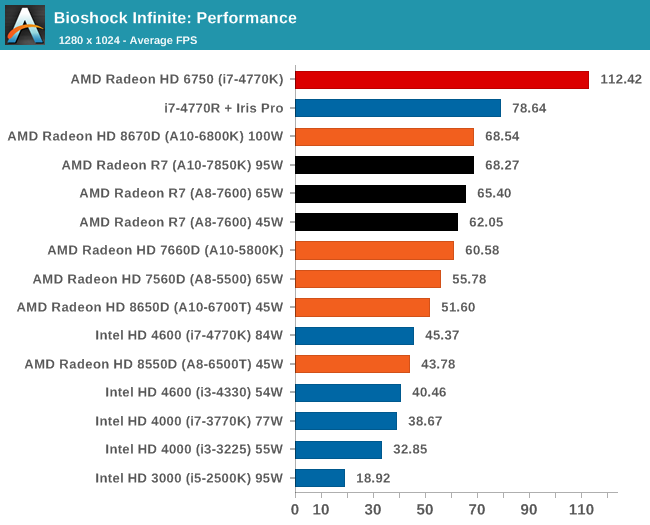
For BI: Performance we see the Iris Pro being top of the IGPs, although the next six in the list are all AMD. The Kaveri cores are all between the 6800K and 5800K for this test, and all comfortably above 60 FPS average.
Bioshock Infinite, Quality Settings

For the quality settings, the Iris Pro starts to struggle and all the R7 based Kaveri APUs jump ahead of the A10-6800K - the top two over the Iris Pro as well.
Bioshock Infinite, Xtreme Settings
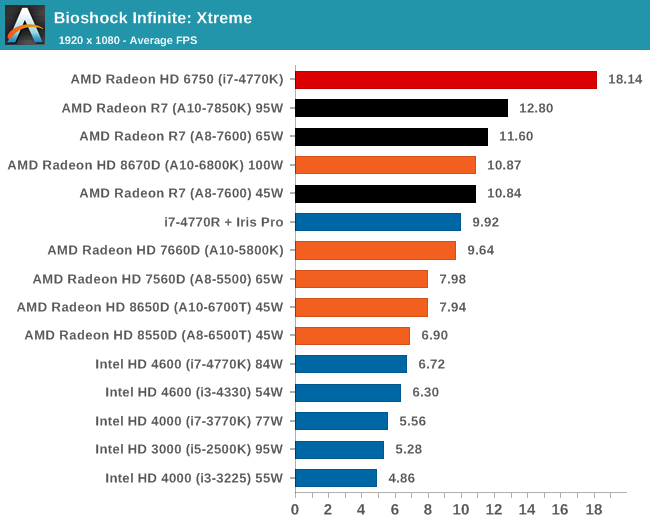
The bigger the resolution, the more the Iris Pro suffers, and Kaveri takes three out of the top four IGP results.
Integrated GPU Performance: Tomb Raider
The second benchmark in our test is Tomb Raider. Tomb Raider is an AMD optimized game, lauded for its use of TressFX creating dynamic hair to increase the immersion in game. Tomb Raider uses a modified version of the Crystal Engine, and enjoys raw horsepower. We test the benchmark using the Adrenaline benchmark tool and their three default settings of Performance (1280x1024, Low), Quality (1680x1050, Medium/High) and Xtreme (1920x1080, Maximum) noting down the average frame rates and the minimum frame rates.
Tomb Raider, Performance Settings
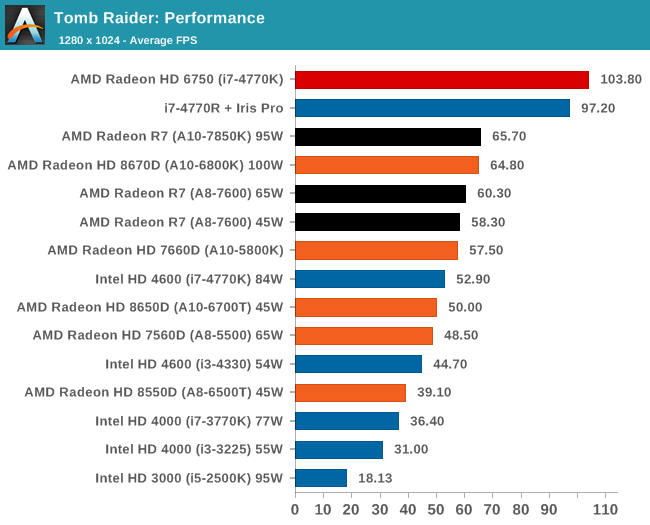
The top IGP for Richland and Kaveri are trading blows in TR.
Tomb Raider, Quality Settings

The Iris Pro takes a small lead, while the Kaveri 95W APU show little improvement over Richland. The 45W APU however is pushing ahead.
Tomb Raider, Xtreme Settings
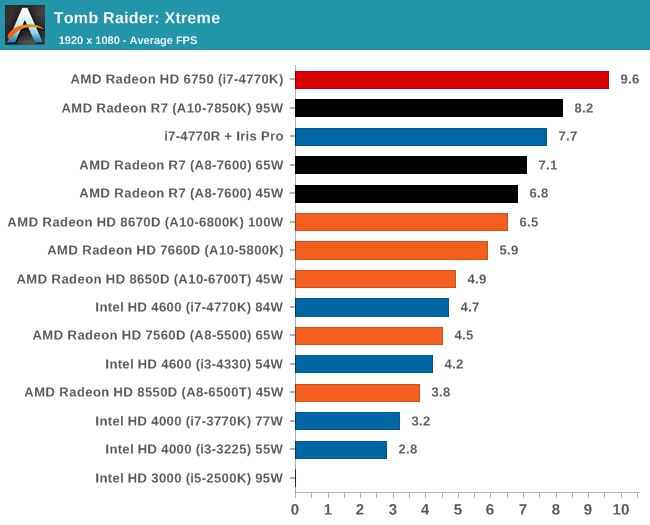
At the maximum resolution, the top Kaveri overtakes Iris Pro, and the 45W Kaveri it still a good margin ahead of the A10-6700T.
Integrated GPU Performance: F1 2013
Next up is F1 2013 by Codemasters. I am a big Formula 1 fan in my spare time, and nothing makes me happier than carving up the field in a Caterham, waving to the Red Bulls as I drive by (because I play on easy and take shortcuts). F1 2013 uses the EGO Engine, and like other Codemasters games ends up being very playable on old hardware quite easily. In order to beef up the benchmark a bit, we devised the following scenario for the benchmark mode: one lap of Spa-Francorchamps in the heavy wet, the benchmark follows Jenson Button in the McLaren who starts on the grid in 22nd place, with the field made up of 11 Williams cars, 5 Marussia and 5 Caterham in that order. This puts emphasis on the CPU to handle the AI in the wet, and allows for a good amount of overtaking during the automated benchmark. We test at three different levels again: 1280x1024 on Low, 1680x1050 on Medium and 1920x1080 on Ultra. Unfortunately due to various circumstances we do not have Iris Pro data for F1 2013.
F1 2013, Performance Settings
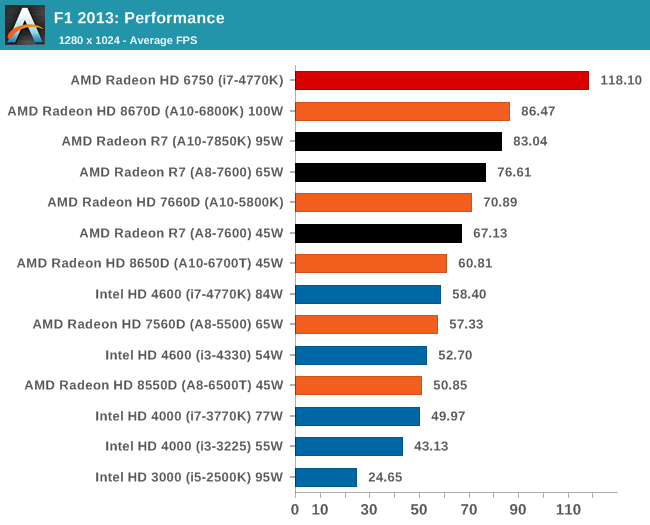
F1 likes AMD here, although moving from Kaveri to Richland at the high end seems a bit of a regression.
F1 2013, Quality Settings
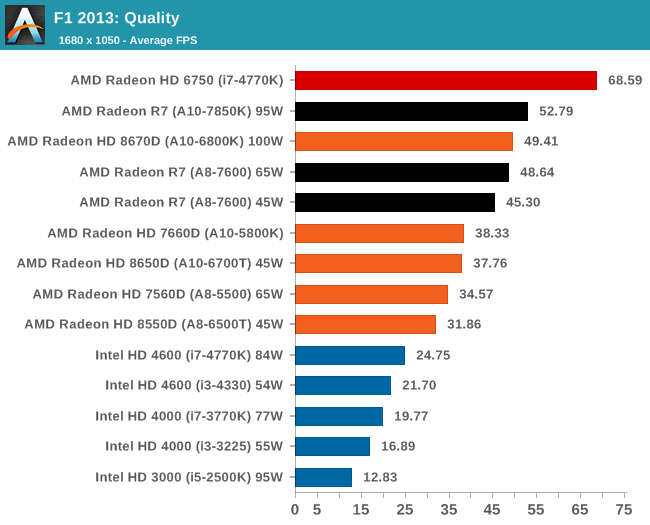
Similarly in the Quality settings, none of the Intel integrated graphics solutions can keep up with AMD, especially Kaveri.
F1 2013, Xtreme Settings

On extreme settings, at 1080p, the top Kaveri APU manages to hit over 30 FPS average during the benchmark. The other A8 Kaveri data is not too far behind.










380 Comments
View All Comments
Fox5 - Tuesday, January 14, 2014 - link
Where are the Iris Pro results in CLBenchmark? Where are the CPU results of CLBenchmark; is the GPU faster than Haswell's AVX2? Where's the rest of the compute benchmarks, the area that Kaveri is supposed to shine in?JDG1980 - Tuesday, January 14, 2014 - link
Incidentally, will HTPC be covered in a different review? MadVR could be a good use case for Kaveri, as it requires quite a bit of shader power but isn't that memory bandwidth intensive.beomagi - Tuesday, January 14, 2014 - link
Per charts, Why are 100W APUs slower in 1280x1024 than at higher resolutions??beomagi - Tuesday, January 14, 2014 - link
Also, 45W APUs are faster? Are the benchmarks different? The charts only mention resolution.beomagi - Tuesday, January 14, 2014 - link
Nevermind - I now see this is as a percent difference compared to the slower chip - the title said FPS and that threw me off.Ignore! :D
Dribble - Tuesday, January 14, 2014 - link
Call me cynical but it's just the same as the previous gen. If you want a small form factor extreme budget gaming box these will be pretty good. For the rest of the world if you don't care about games you'd do better going Intel, and if you do intel + a proper graphics card.As with previous gen it comes with a load of marketing slide advantages, which if previous gen are anything to go by will come to nothing - I don't see the current range of AMD machines blowing away intel machines with opencl/stream/fusion/whatever - and that was what was on the previous set of marketing slides.
I always thought their best bet was mobile - but these days that markets getting really tough now for AMD as Intel have just spent the last few years optimising power usage.
UtilityMax - Tuesday, January 14, 2014 - link
The biggest elephant in the room is that very few average people (those who don't visit this web site) care for playing games on laptops (or even desktops, considering the consoles). Once you ignore the gaming performance, the A10 APU effectively has the performance of Core i3, but at a high price. A Fry's or Best Buy "special" laptop with Core i3 can cost as low as $400 or less. But the A10 laptops cost around $500. Intel's pricing is pretty aggressive on the low end IMHO.jimjamjamie - Thursday, January 16, 2014 - link
Not just in laptops, the price/performance ratio of the dual-core Pentiums is extremely good - the Haswell-based Pentium G3220 (3GHz dual core, 3.5MB cache) is available in the UK for just over £40, which is excellent value.Nagorak - Wednesday, January 15, 2014 - link
Yes, the issue is that the hybridization of CPU/GPU really provides no advantages. For someone actually playing games the GPU is still too weak and they'd be better off with a discrete card. For someone not playing games the quality of the integrated GPU doesn't matter.Maybe I'm wrong and there are tons of people out there playing games at ~30 FPS with low settings. I just don't see why someone who wants to play games wouldn't try to cough up an extra $100 for a discrete GPU, and if you don't play games then even Intel's older HD GPUs are fine.
mikato - Wednesday, January 15, 2014 - link
*For someone actually playing [newer 3D intensive] games the GPU is still too weak and they'd be better off with a discrete card. Yep*For someone actually playing [older or lighter] games the GPU is good enough and you end up with a cheaper overall package without needing a discrete card.
*For someone not playing games, they will benefit big time from HSA eventually. Not there yet and depends on the software.
There are probably more people in the last two categories if you think about it. AMD isn't for us gamers right now unfortunately. And it's going to take a while for adoption for HSA to bring in the third category of people.